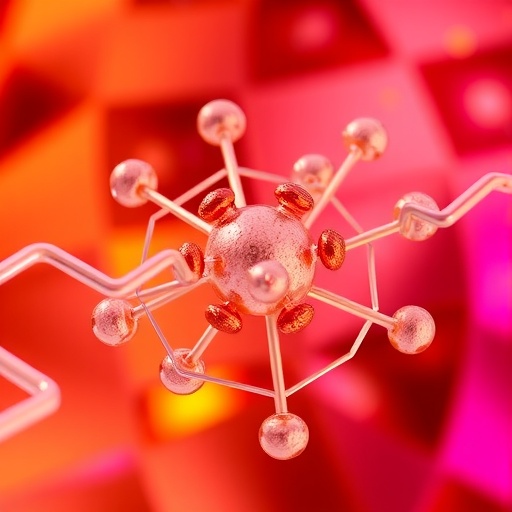Recent research has illuminated the significant role that dipeptides play in the micellization properties of various surface-active ionic liquids, an area of study that holds substantial implications for both industrial and environmental applications. Conducted by an adept team of researchers, including Sharma, Budhalakoti, and Sharma, this investigation delves into the intricate mechanisms at play when dipeptides interact with ionic liquids to form micelles, which are aggregates that can encapsulate other substances, facilitating diverse applications in fields ranging from drug delivery to environmental remediation.
The study reveals a complex interplay between the structural characteristics of dipeptides and the amphiphilic nature of ionic liquids. Dipeptides, composed of two amino acids linked by a peptide bond, exhibit unique properties that can significantly influence the physicochemical behavior of ionic liquids. The researchers meticulously examined how varying the composition of dipeptides affects the critical micelle concentration (CMC) and the stability of micelles formed with different surface-active ionic liquids, providing insightful data on their potential functional benefits.
One of the key findings of the study is the correlation between the hydrophobicity of the dipeptide and the efficiency of micellization. As the hydrophobic character of the dipeptide increases, a decrease in the CMC of the associated ionic liquid is noted, suggesting that the hydrophobic interactions promote micelle formation. This insight underscores the potential for tailoring dipeptide structures to optimize the micellization process, leading to enhanced performance in various applications, including the enhancement of solubility for poorly soluble drugs.
Moreover, the research highlights the significance of the temperature dependency in the micellization process. The scientists discovered that temperature variations could alter the stability and properties of micelles. This finding is particularly crucial, as it poses important considerations for real-world applications where temperature fluctuations are commonplace. For instance, understanding the thermal stability of micelles could enhance their utilization in drug delivery systems, where precise control over delivery is paramount.
The study utilized advanced experimental techniques, including spectroscopy and dynamic light scattering, to meticulously characterize the micelles formed. These methodologies allowed the researchers to observe the size distribution and morphology of micelles, broadening the understanding of how dipeptides influence these aggregates’ structural attributes. The integration of such sophisticated analytical techniques underscores the commitment of the research team to ensuring the reliability and accuracy of their findings.
In addition to understanding the fundamental science, the implications of these findings extend to various industries. The enhanced micellization properties resulting from dipeptide interactions can lead to more efficient formulation processes in pharmaceuticals. By leveraging the unique characteristics of dipeptides, scientists can potentially develop formulations that enhance drug solubility and bioavailability, making a positive impact on therapeutic outcomes for patients.
Furthermore, the environmental implications of this research cannot be overlooked. Ionic liquids have emerged as eco-friendly alternatives to conventional organic solvents. By elucidating how dipeptides can enhance micellization in these ionic liquids, the research paves the way for more sustainable practices in chemical processes and pollution remediation efforts. Micelles can be employed to trap and remove pollutants from water and soil, providing a novel approach to addressing environmental challenges.
As the study progresses, the researchers intend to explore the interactions of dipeptides with ionic liquids further, particularly considering how different environmental conditions affect micellization. They envision investigating the potential for synergistic effects when incorporating multiple dipeptides or other additives, which could reveal new pathways for optimization in various applications. This prospect for future research provides an exciting avenue for advancing the field of ionic liquids and their practical uses.
Collaboration is often vital in scientific research, and this study exemplifies a multidisciplinary approach. The authors’ diverse backgrounds in chemistry, biochemistry, and material science enabled a comprehensive examination of the topic, fostering innovative insights that pave the way for future breakthroughs. Collaborative efforts will continue to be integral in fostering advancements in the understanding and application of dipeptides and ionic liquids.
In conclusion, the groundbreaking work by Sharma, Budhalakoti, and Sharma offers a fresh perspective on the role of dipeptides in modifying the micellization properties of surface-active ionic liquids. This research contributes significantly to the existing body of knowledge, uncovering potential strategies for improving drug formulations and enhancing environmental remedies.
As this research garners attention in the scientific community, it is poised to inspire further investigations that could not only extend the boundaries of knowledge in this field but also yield practical solutions to pressing global challenges. The intricate interactions highlighted in this study emphasize the importance of continued exploration in the realm of ionic liquids, providing a springboard for innovations that couple science with real-world applications.
Moreover, the implications of this research stretch far beyond the laboratory. As industries continue to seek greener alternatives and more efficient processes, the findings surrounding dipeptides and ionic liquids present an exciting opportunity for innovation that aligns with sustainability goals. The potential applications not only underscore the importance of this research but also highlight the collaborative nature of modern scientific inquiry, setting a precedent for future studies in related fields.
As we look to the future, the potential for dipeptides in enhancing the attributes of ionic liquids may pave the way for the next generation of sustainable technology and formulation strategies, marking a significant step towards harmonizing science with societal needs.
Subject of Research: The role of dipeptides in the micellization properties of surface-active ionic liquids.
Article Title: Elucidating the role of dipeptide on the micellization properties of different surface active ionic liquid.
Article References:
Sharma, P., Budhalakoti, B., Sharma, S. et al. Elucidating the role of dipeptide on the micellization properties of different surface active ionic liquid.
Ionics (2025). https://doi.org/10.1007/s11581-025-06782-4
Image Credits: AI Generated
DOI: https://doi.org/10.1007/s11581-025-06782-4
Keywords: dipeptides, ionic liquids, micellization, pharmaceuticals, environmental applications.




